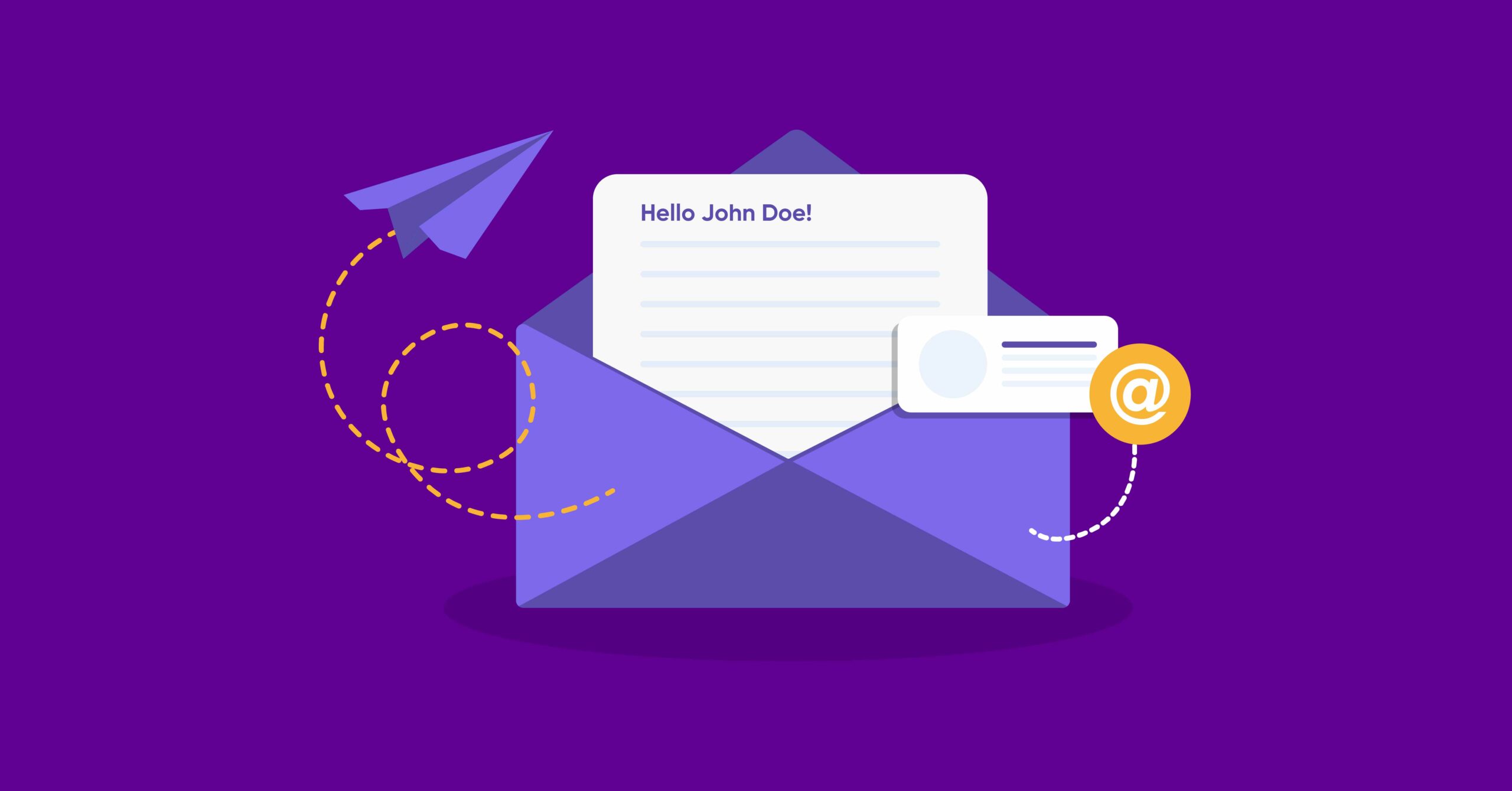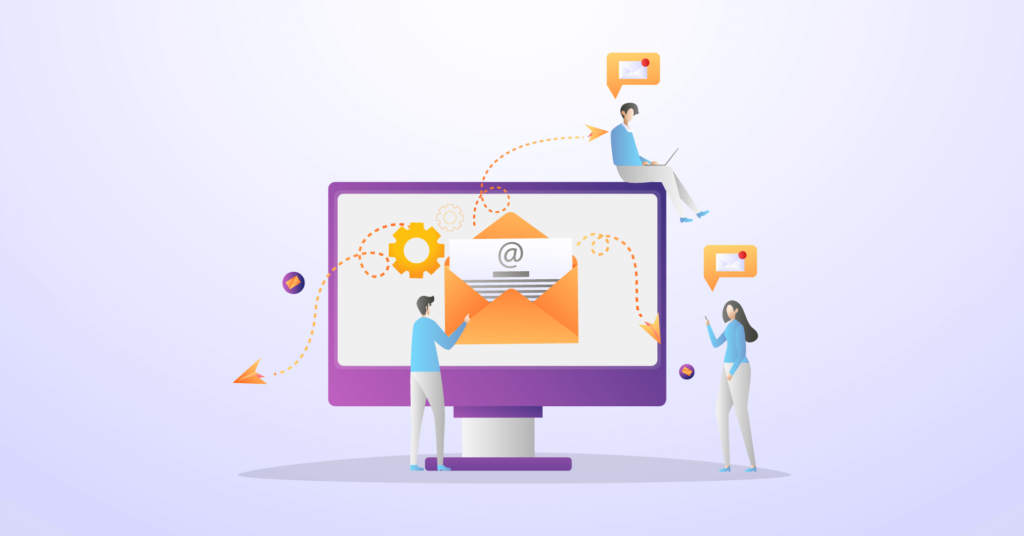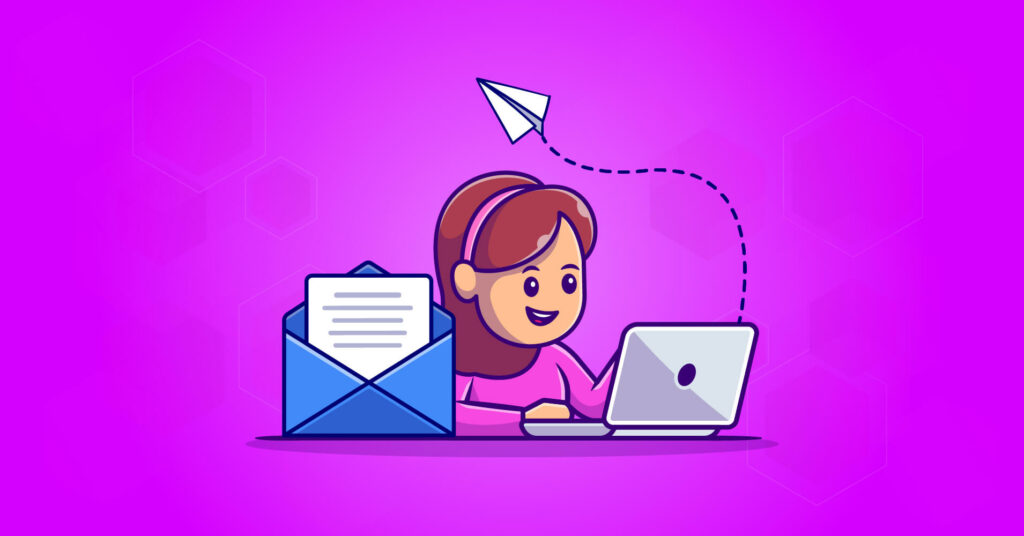
Email Personalization: Definition, Importance, Statistics, and Best Practices
Email marketing is one of the most successful ways of getting closer to your customers by introducing them to your products. But, what can make you stand out from the crowd when there is a market full of email marketers?
In this article, we’ll talk about one of the best ways can set your email marketing above others.
Yes, we’ll discuss email personalization!
Read on to know how it can elevate your email marketing to a new height, its importance, and some best practices that help you personalize your emails.
Let’s begin!
What is Email Personalization?
Email personalization is the process of sending highly targeted emails to your audience using the information you have about your customers or prospects. The email can include their first name, last name, company or business information, products from the cart, their location, or even their purchase information.
Email personalization is a proven way to increase your open and click-through rates. It has a quantifiable impact on business revenue and overall ROI. Instead of getting an irrelevant email from you, your subscribers are more likely to engage when you send an email that makes sense. That’s exactly why email personalization exists.
The Basics of Sending Personalized Email
Email personalization is a process that can make your emails different from others. When customers get a personalized email, they truly feel that they are communicating with a person, not a business.
Email personalization is the masterstroke tactic that helps you squeeze every last drop of your email marketing ROI potential. If you do it a little systematically, email personalization is not a big hill to climb at a basic level. Only three elements make up a great email personalization strategy:
1. Relevance
Most people’s inboxes are often crowded with hundreds of emails from different vendors. Thus, only a few of them get opened and clicked. This is why it’s crucial to send relevant emails that make sense to the audience.
A relevant email is something that your contacts would open and click because you’ll send them what they subscribed for. If they subscribed for discounts on a specific product, inform them when you have a discount on that specific product. The email should always match the user’s intent.
2. Timing
Just like relevance, timing is vital for email personalization. You may send email campaigns daily, weekly, or monthly. But irregular timing in your campaigns can make your subscribers feel uneasy, damaging your chances of success.
If you can send emails when your audience is expecting them, it is easier to achieve success. On the other hand, sending an email at a bad time won’t make sense. This is why it is vital to not only reach out to your audience with the right email but also at the right time.
3. Comes from a Person
Users are more likely to trust a personalized sender name and email address than a generic one. People are so burdened with spam nowadays that they often hesitate to open emails from unknown senders. Customers are more likely to trust a personalized sender name and email address. Therefore, you should always send your emails from a natural person, not a random name or the company name.
Email Personalization Statistics
Email personalization helps you stand out from the crowd. No matter how you tie the numbers together, the following statistics should help you understand the power of email personalization:
- Email personalization is the most efficient email marketing tactic used by email marketers to increase engagement rates. (HubSpot)
- 99% of marketers say personalization helps boost customer relationships, whereas 78% claim it has a “strong” or “powerful” impact. (Evergage)
- Personalized emails increase transaction rates up to 6 times! (Experian)
- Email personalization helps to reduce unsubscription rates by 17% and increase open rates by almost 20%. (Stanford)
- 90% of consumers are more likely to purchase when brands offer personalized experiences. (Epsilon)
- 90% of U.S. consumers find personalized marketing content somewhat very appealing. (Statista)
If you have any doubts about the efficiency of email personalization, the above stats should be enough to motivate you. If not, let’s look at some other reasons why email personalization is vital.
Why is Email Personalization Important?
So, when the question is why use email personalization, you should already know email personalization is essential for many reasons, including showing that you care about your customers and email content when reaching out to new or old customers.
Sending emails the traditional way tends to make your content unattractive or robotic. We know you don’t want this to happen. So here’s why email personalization should be a priority in your email marketing strategy:
Increase Open Rates and Conversion Rates
Of course, you can’t expect any returns from email marketing unless your subscribers are actually opening your emails. Personalization makes this possible. Personalized emails consistently outperform generic messages, driving both higher open rates and increased conversions.
- Personalized emails achieve a 29% higher open rate and a 41% higher click-through rate compared to non-personalized emails236.
- Adding a subscriber’s name to the subject line alone can lift open rates by 26%
- Leveraging customer data-such as purchase history, browsing behavior, and preferences-enables marketers to deliver highly relevant content, resulting in six times higher transaction rates for personalized emails
- Dynamic and behavior-triggered emails, like abandoned cart reminders or tailored product recommendations, further boost engagement and conversion rates
- Brands using advanced personalization strategies report a significant increase in revenue, with some seeing up to a 72X ROI and a 25% increase in customer lifetime value
Modern email marketing tools make it easier than ever to implement these techniques at scale, allowing for real-time customization and adaptive messaging that resonates with each recipient’s unique interests and behaviors
Results in Better Engagement
Email personalization also helps you establish an emotional connection with your audience. By doing so, you can achieve higher engagement with your emails.
Let’s say you’re arranging an event and asking the audience to sign up for it using their name and email address. This is an excellent chance to start engaging them with your brand through a welcome email and nurture them with a few emails before the event starts
Once that’s done, the subscribers will know who you are, what you do, and whether they are interested in staying engaged with your business.
Nurture Relationships with Subscribers
Another reason to select email personalization as the best strategy is to nurture relationships with subscribers.
Everyone loves a little special treatment.
When you show your users that they’re valuable individuals by personalizing the emails, they’ll be more attached to your brand. Let them know about all your upgrades and notify them about all the updates. After any marketing or shipment failure, never forget to send sorry messages.
After all, users expect transparency from brands. Brands that are open to owning their mistakes usually leave a good impression on the users’ psyche.
Helps Create Relevant Content
If you are running a business, you must know how important it is to acquire, attract, and retain customers. The best way to achieve these goals is by ensuring you have content worth reading, offers worth redeeming, and products worth purchasing. That is also where email personalization can benefit you.
As you collect more and more data about your leads and customers, you’ll have a better understanding of what they are looking for and what kind of content they like.
Once you have sufficient data, it’ll be easier for you to develop an excellent newsletter content strategy for driving more traffic to your website.
Motivates Users to Share Personal Data
83% of consumers are willing to share personal data with brands if that helps the brand personalize their offers and promotions based on the data. People like brands that ease their lives. When they get all the information and offers while they relax in the bedroom, why won’t they share their data?
However, it is equally important that brands are transparent about using the information they acquired from the consumers.
Let’s say someone subscribes to receive newsletters from a sports equipment online store. The store should inform that they will use the gender and age information to send exciting email campaigns during the subscription(if they’re planning to do so).
This helps build credibility and trust. Hence, motivating the users to share personal data.
Boost ROI
According to the Data and Management Association(DMA), segmented campaigns result in a 760% increase in revenue compared to one-size-fits-all campaigns.
Emails with personalized subject lines have a 26% higher chance to be opened. More open rates mean more clicks and more clicks often mean more sales!
Targeting your customers with the right message at the right time helps you cut through the noise. It creates a faster path to revenue.
If you’re still not convinced, read our article on the importance of email personalization.
Email Personalization Best Practices

Email personalization helps you better engage your target audience than typical, one-size-fits-all emails or offers. When users receive emails using their name, location, information about them, or other personalized information, it makes them feel like you’re writing personally to them. It makes them interested in what you have to say.
If you assume email marketing is a planet, email personalization would be the sun, the powerhouse it should revolve around. Maybe you can’t use the full power of the sun. But with some expertise, you can surely achieve new heights.
Email marketing gets much better if you can implement the right personalization techniques. So let’s see some email personalization best practices:
Create Customer Personas
Buyer personas are the way you understand your customers better. It helps you tailor your content, emails, product, and services to meet the specific intents, actions, and concerns of the users of your target audience.
For example, if your target buyers are bikers, you have to know what their specific needs and interests are and the typical background of your potential customers. Understanding your customers is easy, but tactical to develop detailed personas for your business.
Market research and the metrics you gather from the existing customer base through surveys, interviews, etc., can find your strongest buyer personas.
If you’re new to personas, start small. You could have one or two personas for your business. Depending on your business, it can be as many as 10 or 20. You can constantly develop more personas later if needed.
Email List Segmentation
One of the easiest ways to personalize your emails is by segmenting your list by customer preferences. Segmentation is putting your contacts into groups based on what they have in common. Some email segmentation can be based on:
- Location
- Gender
- Role in an organization
The criteria for segmenting your list depend on your industry and goals. However, using that little bit of data in an email will make your subscriber feel like a one-on-one conversation. That will connect them to your brand email, engage with your offerings, and hopefully, complete the action you want from them.
Segmentation forms the base of most, if not all, email personalization techniques.
Subject Line Personalization
The subject line is the second line of text readers see when they receive your email campaigns. As mentioned earlier, personalized subject lines receive up to 26% open rates, which is an effective booster.
So add the customer’s name on the subject line using personalization tags. It is also possible to personalize a subject line when you send behavioral emails. In that case, you’ll be personalizing your subject line based on your customer’s past behavior.
Make your subject line worthy and relevant, and you won’t regret it. An efficient subject line does the half work for you. The subject line should reflect the campaign’s goal and entice readers to open it at first sight.
Personalize Email Content
When it comes to email marketing, your content is the medium of connection. To improve this connection, personalize your content.
Make your email less formal, whatever industry you’re in. Your email should be cordial and warm. And finally, avoid jargon at all costs.
Humor is one of the best ways of breaking the ice in any situation. Even in your emails, humor will make your emails feel like coming from a friend, not a business.
Be a friend they can turn to when they need a product or service you offer. Creating personalized content ensures that your customer looks forward to interacting with your emails.
Use Attractive Graphical Visuals
“A good first impression can work wonders.“
– J K Rowling
The first impression of your email is its graphical visualization. This can be custom images that you use, or simply the visual appeal if you only send plain-text emails.
Whenever users open the email, they see your entire message before reading it. So it should be a crucial part of your emails.
A good email layout should lead the readers’ eyes toward the critical part. So include anything the email needs to attract the users. Just beware of the bad data visualizations and keep it concise.
But as a rule of thumb, here are some of the essential graphics you should have in your email layout:
- Logo: Let the users know about your brand.
- Brand color: Helps you maintain consistency throughout the email
- Fonts: Ensures readability of your content
- Call-to-action buttons: That’s the decision-making part for your users.
- White space: give some visual breaks for your readers.
- Other graphics: include images, videos, or illustrations.
Send Emails from a Person, Not the Business
It can be a great strategy to personalize your emails from a person. Research says that people are more likely to trust and relate to an email from another person than they would an email from a business. 68% of Americans stated the “From” name plays a significant role in their decision to open an email.
Hubspot ran statistics on the users. When they sent emails from “Hubspot,” their click-through rate was 0.73%. After switching to sending their emails from a person’s name, the click-through rate jumped to 0.96%.
Do you think it’s a mini increase?
No, it was 292 more clicks —well worth making a small change for improvement!
That is why we recommend personalizing your emails using a person’s name in the “From” field and adding a person’s face instead of a logo or an avatar.
Send Triggered Emails Depending on Customer Behavior
One of the best email personalization strategies is to send behavioral emails. It is whereby you use an email marketing tool like FluentCRM to automatically send emails to subscribers based on specific goals or actions defined by you. Personalization by email automation is so powerful that research shows it can increase up to 75% of some businesses’ revenue.
Email marketing automation helps you send personalized emails by analyzing your subscriber’s actions. These triggered or behavioral emails are a great way of making a subscriber feel like you know them. Welcome emails, reminders, lead nurturing emails, or reactivation emails are some great examples of triggered emails.
Allow Subscribers to Set Preferences
51% of people unsubscribe because they receive emails too often. And 49% would like to receive an email at a frequency they choose rather than the brand chosen for them. It’s about personalizing the subscriber’s experiences.
Read: Email Frequency Best Practices
About 74% of consumers would find “living profiles” like preference centers valuable if they could use them to curate the experiences, offers, and products they receive.
If you represent sports news resources, let people decide upon the desired content to receive: cricket, football, tennis, badminton, etc. It helps build credibility between you and the audience and gets data for more advanced personalization in the future.
Therefore, add the preferences block in your email’s footer to gain credibility. Here’s an example of email preference management from FluentCRM:
Use Personalization Naturally
As an email marketer, you should never forget you’re merely a guest in your users’ inboxes. Just because you have information about them doesn’t mean you should use it all the time. Never make them feel it is forced. Email personalization should come across as natural.
Personalization should make it frequent to build a personal connection with your users. It will also help you create relevant and timely email content. Overall, you should only use it when it makes sense.
Take Control of Your Email Marketing
That wasn’t all. That can’t be.
Email personalization is a big book to read. But, hopefully, you now know a bit more about email personalization, don’t you?
Here we talked about the importance of email personalization. Maybe you faced difficulties or are still facing difficulties in personalizing your emails. Hopefully, you can figure out some tactics you can use to personalize your emails.
Feel free to comment if you want to add your thoughts here. Good luck writing great personalized emails that get opens, clicks, replies, and sales!









Leave a Reply